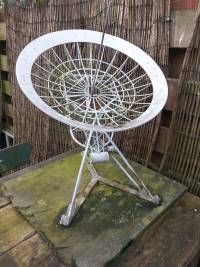Table of Contents
Jan Oort
Short facts
- Born: 28 April 1900
- Died: 5 November 1992 (aged 92)
- Nationality: Dutch
- Spouse: Mieke Graadt van Roggen
- Children: Coenraad Jan (Coen), …
Life
Jan Hendrik Oort (Franeker, 28 April 1900 – Leiden, 5 November 1992) was a prolific Dutch astronomer. He made many important contributions in the field of astronomy and was a pioneer in the field of radio astronomy.[2] In 1932 he became the first person to discover evidence of dark matter. First proposed by Swiss astronomer Fritz Zwicky in the 1930s, at nearly the same time, Jan Oort in the Netherlands discovered that the density of matter near the Sun was nearly twice what could be explained by the presence of stars and gas alone. The Oort cloud of comets bears his name.
Anecdotes
Oort may be considered the most famous Dutch astronomer. Oort made important contributions to many areas of Astronomy. He managed to purposefully make his way through the labyrinth of all available observations and the sometimes less than stellar interpretations of these observations. This became very obvious during one of Oort's classes, when he explained something to a couple of students who didn't automatically see that he was on the right track. “But professor, this article tells us something different, shouldn't that be investigated too.” To which Oort replied, with a characteristic gesture: “Oh, if you already know now that you're right, you can just ignore other opinions.”
Oort had the same characteristics as Hertzsprung. Like Hertzsprung he was very precise, neat and very driven. Whenever Oort walked through the halls of the Old Observatory and saw some litter on the ground, he would pick it up and put it in the bin. He felt the Observatory should look clean. Oort's office was always known as the most ordened place in the Universe.
During the colloquium at the Observatory, Oort always sat on the front row (he was a little deaf). After the colloquium he would look around the room to see who did and who didn't attend. The next day he would speak to the absentees during the coffee break: “Why weren't you at the colloquium yesterday?”
Oort also contributed greatly to radio astronomy. The new radio telescope in Dwingeloo was opened in 1956. The opening was officially performed by H.R.M. Queen Juliana. At Oort's friendly invitation the Queen pushed a button, which was supposed to put the giant dish in motion. However, since the connection between the button and the steering mechanism wasn't finished in time, pushing the button led to a different result. A bell sounded in the telescope cabin, where some tough astronomers had their hands on the steering mechanism to move the dish manually. When the bell sounded, however, tension was so high that the gentlemen first moved the telescope in the wrong direction for a little bit, stopped, and then moved it to follow the actual daily motion of objects in the sky. No laughter sounded outside; luckily only insiders noticed the flaw. The outbursts of laughers followed later on. (taken from “but it is Sunday today professor”)
The children of Jan Oort used to play games in the Hortus Botanicus, although they were not allowed to be there. They used to climb over the fence and change all the signs of the plants.
J. H. Oort

 Jan Hendrik Oort, (1900 - 1992), studied at the University of Groningen. Oort was appointed astronomer to the Leiden Observatory in 1924 and became director in 1945, a position he held until 1970. Oort was able to confirm the galactic rotation theory of Bertil Lindblad in 1927 through his own direct observations of star velocities in the galaxy, and he modified the theory substantially into the form used thereafter. The discovery in 1951 of the 21-cm radio waves generated by hydrogen in interstellar space provided him with a new method for mapping the spiral structure of the galaxy.
In 1950 Oort proposed that comets originate from a vast cloud of small bodies that orbit the Sun at a distance of about one light-year, later named the Oort Cloud.
Through his skilled actions, and his scientific prestige, the radio telescopes in Dwingeloo and Westerbork were realized, and gave the Netherlands access to the most powerful instruments of the time.
From 1958 to 1961 Oort was president of the International Astronomical Union, of which he had been general secretary from 1935 to 1948.
Jan Hendrik Oort, (1900 - 1992), studied at the University of Groningen. Oort was appointed astronomer to the Leiden Observatory in 1924 and became director in 1945, a position he held until 1970. Oort was able to confirm the galactic rotation theory of Bertil Lindblad in 1927 through his own direct observations of star velocities in the galaxy, and he modified the theory substantially into the form used thereafter. The discovery in 1951 of the 21-cm radio waves generated by hydrogen in interstellar space provided him with a new method for mapping the spiral structure of the galaxy.
In 1950 Oort proposed that comets originate from a vast cloud of small bodies that orbit the Sun at a distance of about one light-year, later named the Oort Cloud.
Through his skilled actions, and his scientific prestige, the radio telescopes in Dwingeloo and Westerbork were realized, and gave the Netherlands access to the most powerful instruments of the time.
From 1958 to 1961 Oort was president of the International Astronomical Union, of which he had been general secretary from 1935 to 1948.
Sundial
In 1969 Prof. Oort went retired at 70, for his retirement party he got a custom built sundial that looks like the Westerbork telescope. Here you can see a transcript of the happening from the annual report. Right now the sundial is in the possession of his grandson Marc Oort.


